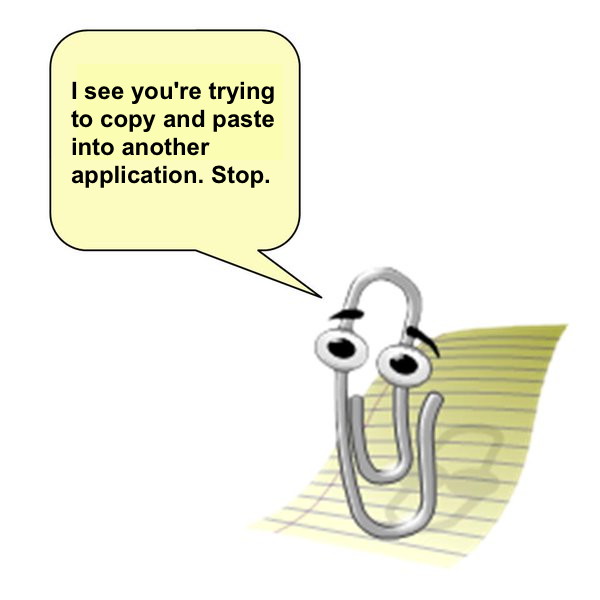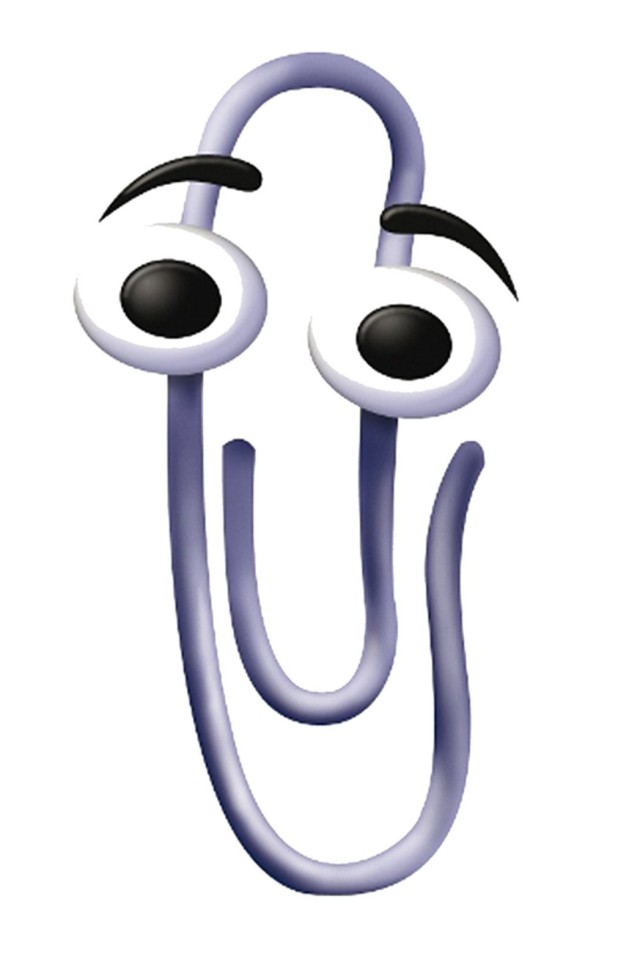Old MS Word Office assistant is now back once again! Inside old Word applications Clippy was not so useful but he always had great comment or two. This extension will provide clippy inside every website you visit. For some website Clippy will make a random comment based on the public repository file. Clippy: You said Dear, that is usually how you start a letter. Me: Ohhh, no I wasn’t saying D-E-A-R, i was saying D-E-E-R. Clippy: Oh, well then maybe I should run spell check because you misspelled it. Today, designer Michael McMillan has introduced a free WordArt generator that you can use to make all kinds of beautiful words (with the help of Clippy, of course).
Remember Clippy? You probably either loved or hated him.Source:Supplied
WHETHER you loved him, or you hated him, you no doubt remember Clippy.
For those born before the late 90s, the little paperclip character with his big eyeballs and incessant need to help will forever be synonymous with Microsoft Word and the early days of personal computing.
But there’s a lot you probably don’t know about the life of Clippy (because why would you?). Despite becoming an indelible feature of the early editions of Microsoft’s home office software, it wasn’t always smooth sailing for the little mascot that just wanted to help.
Clippy — who was originally named Clippit — was the onscreen assistant from Microsoft Office products in the late 1990s and early 2000s. He would appear on screen unprompted with suggestions that were supposed to be helpful. But like an annoying younger sibling who wouldn’t leave you alone when you were hanging out with your older friends, Clippy’s constant nagging and seemingly random suggestions quickly became annoying.
But that wouldn't have shocked Microsoft. In early focus group testing, the anthropomorphised paperclip wasn’t exactly a hit with the public.
A Microsoft executive at the time, Roz Ho, once said in focus group testing the results came back “kind of negative.”
Clippy Word 2016

In particular women didn’t like him because they thought that Clippy were leering at them. After all, who wants a creepy paperclip eyeballing you when you’re trying to write a letter. Those eyebrows said so much.
Bill Gates on stage with ClippySource:Supplied
Clippy Word 2016
The engineers basically decided to disregard the focus group feedback and shipped Clippy as he was. As a result it turned out to be one of the most unpopular features ever introduced, especially among female users.
In 2010, TIME Magazine named it as one of the 50 worst inventions of all time.
“At one point he was annoying hundreds of millions of people a day, which was kind of funny,” said Clippy illustrator Kevan Atteberry. So it’s no surprise that he became rather detested by some.
“They f***ing hate him! And you know what, that’s fine. Any press is good press. But to be honest, not everybody hates him. I get a dozen pieces of fan mail from people that just loved Clippy,” he told Motherboard earlier this year.
As the visual creator of Clippy, Mr Atteberry was originally embarrassed by being the father of the most hated paperclip in the world and didn’t include the character in his portfolio of works. That was until eventually he realised Clippy’s notoriety carried with it a certain cache for the man behind it.
Among some hardcore fans, Clippy has even become a cult favourite appearing on clothes and various memorabilia. It has even been the subject of bizarre fan art, including erotic fan fiction.
Clippy fan art has taken off, even including some erotica.Source:Supplied
A fine read, I'm sure.Source:Supplied
These days so many of our products are imbued with digital helpers, such as Apple’s Siri or Alexa in Amazon’s smart home speaker. But while they have the privilege of being powered by artificial intelligence and machine learning to help them help us, it’s not hard to view Clippy as an early version of such systems - a clunky pioneer of digital assistants from an age when IT was much much simpler.

And, as they say, the first one through the wall always gets bloody.
Less than six years after his debut in Windows Office 1997, Clippy went into an early retirement in 2002 when he was turned off by default, meaning most users at the time probably never saw him.
When then Microsoft CEO Bill Gates announced Clippy’s retirement in 2001, saying “XP stands for Ex-Paperclip,” he got a standing ovation. Poor Clippy.
He finally departed the digital domain in 2007 when Microsoft Office dismissed him all together. Unlike when Microsoft tried to kill off its Paint program earlier this year, there was no protest or outcry over the death of Clippy.
Clippy just showed up in the press room at #MSBuild and everyone is more excited about this than anything we saw onstage pic.twitter.com/Ibgga5LXBh
— Karissa Bell (@karissabe) May 11, 2017He may have been killed off long ago, and without much fanfare, but his memory lives on. Clippy is firmly entrenched in the pantheon of 90s nostalgia and an appearance of a Clippy mascot at Microsoft’s BUILD conference this year proved he is far from forgotten.
“He’s still part of our culture,” Mr Atteberry said. “Even though he hasn’t been an active part of our culture, even though he hasn’t been part of the software in decades.
“The fact that people despise him or hold him in disdain is probably what keeps him in the forefront of our memory.”

RIP Clippy.
Why did Clippy have to die. He was just a boy. It's not fair.
We'll never forget you Clippy pic.twitter.com/USqfYu56CD
Bill Gates 1999 predictions
First Look Microsoft has released Office 2016 for Windows, over two and half years after the launch of Office 2013 in January of that year.
The Office team has been busy in the intervening period – and not just with Office 2016. March 2014 saw the release of Office for iPad, including Word, Excel, PowerPoint and OneNote in touch-optimised versions, which pack a lot of features behind a simplified user interface.
This was followed by versions for iPhone, Android tablets and phones, and Office mobile apps for Windows 10, all of which have similar features and, we are told, are built from the same code base.
Office also has a cloud component, via integration with Office 365, Microsoft’s hosted email and productivity suite. The core cloud product is SharePoint Online, for document storage and collaboration, which includes Office Web Apps for creating and editing documents in the browser.
This is supplemented by other applications, including Office Sway for online presentations, and Office Delve, which performs contextual search across SharePoint Online informed by what the company calls the Office Graph – data derived from your contacts and usage of Office 365.
Delve has mobile apps for iOS and Android, but Windows users miss out.
There are also versions of Outlook, Microsoft’s email and calendaring application, for iOS and Android, as well as Windows and Mac. The mobile versions of Outlook are based on Microsoft’s December 2014 acquisition of Accompli – they handle not only Office 365 and Exchange email, but also Google Mail, iCloud, Yahoo and any IMAP server.
Microsoft’s Office strategy seems to be about supporting Office 365 and maintaining its position as the dominant format for business documents by supporting all the most popular platforms, rather than focusing on the Windows product suite.
This strategy, along with the fact that the core products are more than mature – Excel for Windows goes back to 1987, Word to 1989 – may be the reason why Office 2016 is not replete with new features.
The core of these applications seems little changed in this release, and there is nothing in Word that will change the mind of Charlie Stross, who a couple of years back wrote that “Word was in fact broken by design, from the outset – and it only got worse from there.”
For years, Word experts have recommended against using the Master Document feature for long documents, because they corrupt, and this release is unlikely to be different. Outlook’s user interface remains convoluted for advanced tasks, such as opening another user’s mailbox. This option is buried in File > Account Settings > Select account > Change > More Settings > Advanced tab. Phew.
Will Microsoft ever fix such issues? Dream on.

What is new, then? When Office 2013 was released, Microsoft applied a touch of Metro design, visible in all CAPS menus and a washed-out appearance that was in line with content-first principles, though this made little sense in the context of editing tools.
Office 2016 restores upper and lower case menus and adds a new “colourful” theme as the default – an improvement, in my view. There is also a Dark theme, which Microsoft says is aimed at people with visual impairments.
The next thing you will notice is a lightbulb in the ribbon menu in Word, Excel and PowerPoint, captioned “Tell me what you want to do”. The idea is that rather than hunting through the ribbon, you type something here: “Spell check” in Word, for example. The action you want should then appear in a list, and when you select it, it is performed.
Office 2016 'Tell Me' found the right place to show a second time zone
“Tell Me” is the latest effort to make Office easier to use. Some will remember Clippy and “it looks like you’re writing a letter” in Office 97. Unlike Clippy, “Tell Me” does not get in the way, but functions as a kind of search-driven user interface. It responds to the Alt-Q keyboard shortcut and works well if you would rather not pick up the mouse, or are not sure where to find a command.
In Outlook, I typed “Show another time zone”, and Tell Me successfully found Calendar Options. In Excel I typed “Find the average” but this seemed to stump Tell Me, which offered AutoSum, though there is a Help option that did open a relevant topic.
